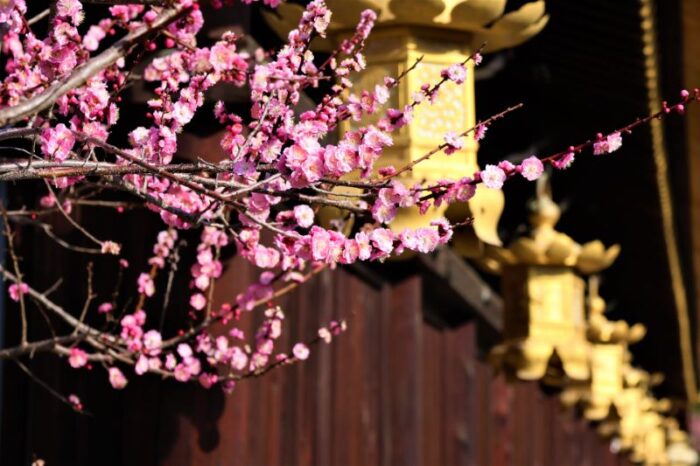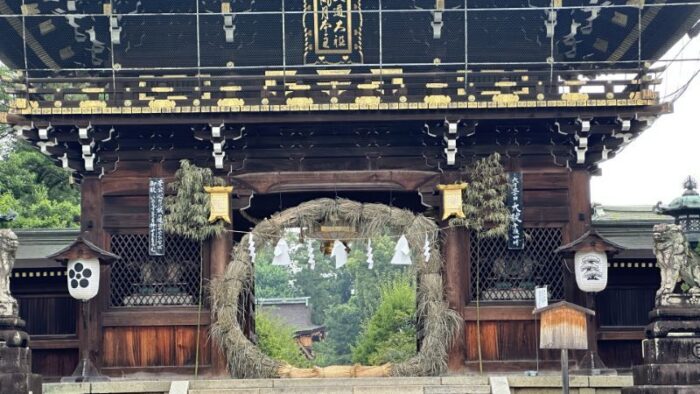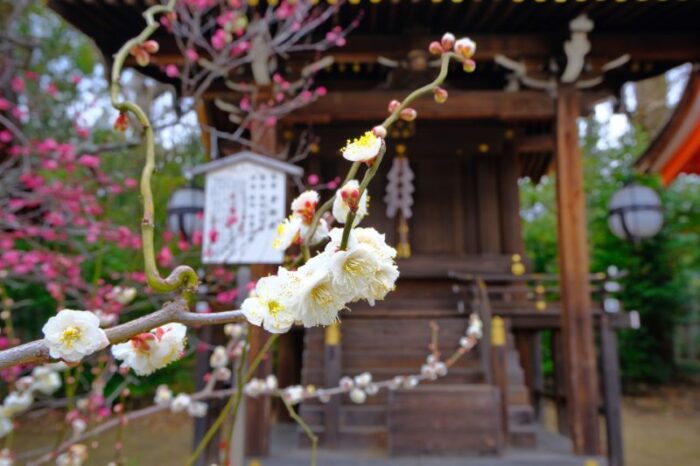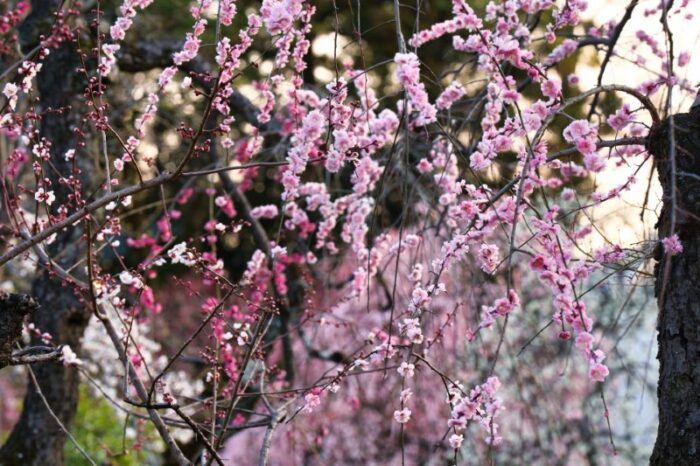The Kitano Tenmangū Shrine, located in Kyoto, is a significant shrine that deifies the god of scholarship, Tenjin. It’s the head of over 10,000 Tenmangū shrines in Japan and was founded in 947 AD to honor Sugawara no Michizane, a prominent politician during the Heian period.

The shrine was constructed to alleviate his spirit and seek forgiveness after his exile from Kyoto and the alleged death of the emperor’s sons caused by his posthumous wrath. The shrine is known for its annual Baikasai Festival, which honors Michizane’s passing and features important rites, celebrations of tranquility amidst blooming plum trees, and interactions with geisha.

Plus, the shrine hosts the Nodate Ohchanoyu, an outdoor tea ceremony organized by Toyotomi Hideyoshi in 1587 to unify Japan. This festival involves maiko, geiko, and Okami and offers a unique opportunity to experience Japanese traditions and local culture.
Other festivals and events in the area, such as the Hatsu Uma Daikondaki festival at the Sanzen-in Temple, also provide a chance to witness the convergence of Shinto spirituality and beauty.
Key Takeaways
- Kitano Tenmangū Shrine is located in northwestern Kyoto and is dedicated to the god of scholarship, Tenjin.
- The shrine was founded in 947 AD to honor Sugawara no Michizane, a prominent politician during the Heian period who was exiled from Kyoto.
- The Baikasai Festival, held on February 25th each year, honors Sugawara no Michizane’s passing and features important rites and tea ceremonies.
- Nodate Ohchanoyu, organized by Toyotomi Hideyoshi, is an annual event held at Kitano Tenmangu, where tea is served to guests amidst blooming plum trees.
The Significance of Kitano Tenmangū Shrine in Shinto Spirituality

The significance of Kitano Tenmangū Shrine in Shinto spirituality is reflected in its role as a place of worship and reverence for the god of scholarship, Tenjin. Located in northwestern Kyoto, this shrine holds great importance as it is the head of over 10,000 Tenmangū shrines in Japan.
Its origins can be traced back to 947 AD when it was founded to honor Sugawara no Michizane, a prominent politician during the Heian period. This shrine is unique as it was the first in Japan to enshrine a political figure.
The legacy of Kitano Tenmangū Shrine is further highlighted by the annual Baikasai Festival, which honors Sugawara no Michizane’s passing and allows visitors to celebrate tranquility amidst blooming plum trees. This festival, along with other events held at the shrine, provides an opportunity to experience Japanese traditions and the beauty of Shinto spirituality.
The Baikasai Festival: A Celebration of Plum Blossoms and Tranquility

Visitors to the Baikasai Festival can enjoy the serene ambiance of blooming plum trees and participate in traditional tea ceremonies.
This annual festival, held at the Kitano Tenmangū Shrine in Kyoto, is a celebration of tranquility and beauty.
The festival, which honors the passing of Sugawara no Michizane, features important rites inside the shrine’s main hall and offers a chance to witness geiko and maiko from the Kamishichiken District wearing plum-themed kimonos.
One of the highlights of the festival is the Nodate Ohchanoyu, an outdoor tea ceremony where participants can interact with geisha while surrounded by the blossoming plum trees.
It is truly a unique and immersive experience, allowing visitors to not only appreciate the beauty of the plum blossoms, but also to engage with Japanese traditions and local culture.
| Baikasai Festival Highlights | ||
|---|---|---|
| Blooming Plum Trees | Traditional Tea Ceremonies | Geiko and Maiko in Plum-themed Kimonos |
| Important Rites in Shrine’s Main Hall | Nodate Ohchanoyu Outdoor Tea Ceremony | Interaction with Geisha |
| Celebration of Tranquility | Immersion in Japanese Traditions | Appreciation of Local Culture |
Nodate Ohchanoyu: A Traditional Tea Ceremony Amidst Plum Trees

Participants at the Nodate Ohchanoyu, held annually at the Kitano Tenmangū Shrine, have the unique opportunity to engage with geisha while enjoying the serene ambiance of blooming plum trees. This traditional tea ceremony takes place amidst the natural beauty of the shrine’s grounds, creating a tranquil and enchanting experience for all who attend.
Here are four reasons why the Nodate Ohchanoyu is a must-see event:
- Cultural immersion: Guests can witness the art of tea preparation and the grace of geisha up close, gaining a deeper understanding of Japanese traditions and customs.
- Natural beauty: The blooming plum trees provide a breathtaking backdrop, creating a picturesque setting that enhances the overall experience.
- Authenticity: The Nodate Ohchanoyu is organized by the Kitano Tenmangu Shrine, a historical and revered institution, ensuring an authentic and genuine tea ceremony experience.
- Exclusivity: This event is not open to the general public, making it a rare opportunity to partake in a truly unique and intimate gathering.
Attending the Nodate Ohchanoyu is an extraordinary way to connect with Japanese culture and immerse oneself in the beauty of the plum blossom season.
Other Festivals and Events: Embracing Shinto Spirituality and Local Culture
The Hatsu Uma Daikondaki festival at Sanzen-in Temple in Ōhara village gathers local women and parishioners to make daikon radish soup, bringing together the community to celebrate Japanese traditions and local culture.
This festival is held in early January, marking the beginning of the new year. The daikon radish soup, known as ‘daikondaki,’ is a traditional dish believed to bring good luck and health for the year ahead. Participants peel and slice the daikon radishes, then cook them in a flavorful broth.
While preparing the soup, they share stories, laughter, and a sense of camaraderie. The aroma of the simmering soup fills the air, creating a warm and welcoming atmosphere.
This event not only celebrates the culinary heritage of the Ōhara area but also fosters a deep sense of community and appreciation for Japanese traditions.
Frequently Asked Questions
What Is the Significance of Plum Blossoms in Shinto Spirituality?
Plum blossoms hold great significance in Shinto spirituality. They symbolize renewal, purity, and the transient nature of life. In Shinto belief, they are seen as a sacred symbol of the divine and are often associated with prayers for good fortune and blessings.
How Are Geiko and Maiko Involved in the Baikasai Festival?
Geiko and maiko from Kamishichiken District play an important role in the Baikasai Festival at Kitano Tenmangū Shrine. They wear plum-themed kimonos and participate in the outdoor tea ceremony, adding elegance and grace to the celebration.
What Is the History Behind the Nodate Ohchanoyu Tea Ceremony?
The history behind the Nodate Ohchanoyu tea ceremony at Kitano Tenmangū Shrine dates back to 1587 when Toyotomi Hideyoshi organized it to unify Japan. The ceremony serves tea to invited guests amidst blooming plum trees, creating a serene and culturally rich experience.
How Do Local Women and Parishioners Participate in the Hatsu Uma Daikondaki Festival?
Local women and parishioners participate in the Hatsu Uma Daikondaki festival at Sanzen-in Temple in Ōhara village by gathering to make daikon radish soup. This event showcases Shinto spirituality and allows for a celebration of Japanese traditions and local culture.
What Are Some Other Ways to Experience Shinto Spirituality and Local Culture in the ŌHara Area?
In the Ōhara area, one can experience Shinto spirituality and local culture through festivals like the Hatsu Uma Daikondaki at Sanzen-in Temple. Local women and parishioners gather to make daikon radish soup, showcasing the unique traditions and beauty of the region.
The Sum Up
To sum it up, the Kitano Tenmangū Shrine in Kyoto is not only a significant place of worship, but also a hub of cultural and spiritual activities.
Its annual Baikasai Festival, with its tranquil plum blossoms and geisha interactions, offers a unique experience of Japanese traditions. The Nodate Ohchanoyu tea ceremony, held amidst the beautiful plum trees, is a testament to the shrine’s rich history and commitment to preserving local culture.
With other events like the Hatsu Uma Daikondaki festival, visitors can witness the convergence of Shinto spirituality and beauty.
Don’t miss the chance to immerse yourself in the enchanting world of Kitano Tenmangū Shrine and its vibrant celebrations.




